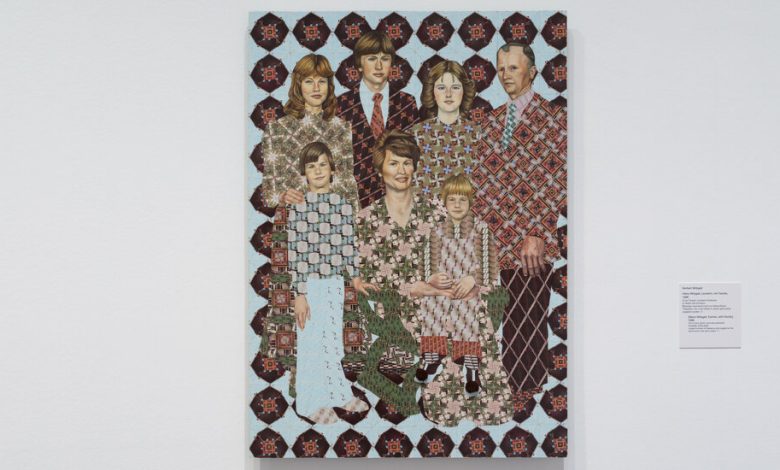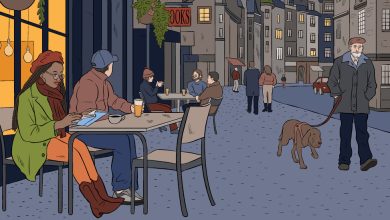Did Someone With a Trust Fund Paint This?

BERLIN — Artist name, date of birth, nationality. The typical biographical information on wall labels in museums and galleries across the world. But in a new exhibition at the Berlinische Galerie here, visitors will find more revealing facts: “Parents’ professions,” “Hours of unpaid labor” or “Largest number of freelance jobs juggled at the same time.” (In the case of the artist Norbert Witzgall, the answer to the last one is 11.)
In the show, called “Class Issues” and running through Jan. 9, 2023, many of the artworks, both contemporary and historical, are about financial and social inequality.
Some are funny, like a film by Margit Czenki documenting a satirical 1998 performance in which protesters marched through downtown Hamburg chanting “Help the Rich!” and polishing the hoods of fancy cars.
Elsewhere are more heart-wrenching documentary exhibits. Lining the wall at the entrance is a series of anonymized letters from artists aged over 60, requesting financial aid from a professional association during the coronavirus pandemic. In a nearby corner are hand-drawn charts from a survey of Berlin artists by a French collective that found respondents’ median annual income was 15,000 euros, around $15,800, with roughly half of these artists more than 15 years into their careers.
The Fine Arts & Exhibits Special Section
- Bigger and Better: While the Covid-19 pandemic forced museums to close for months, cut staff and reduce expenses, several of them have nevertheless moved forward on ambitious renovations or new buildings.
- A Tribute to Black Artists: Four museums across the country are featuring exhibitions this fall that recognize the work of African and African American artists, signaling a change in attitude — and priorities.
- New and Old: In California, museums are celebrating and embracing Latino and Chicano art and artists. And the La Brea Tar Pits & Museum is working to engage visitors about the realities of climate change.
- A Cultural Correction: After removing all references to Columbus from its collections the Denver Art Museum has embraced a new exhibition on Latin American art.
- More From the Special Section: Museums, galleries and auction houses are opening their doors wider than ever to new artists, new concepts and new traditions.
Museums worldwide have been increasingly vocal about promoting racial and gender diversity when acquiring and exhibiting artworks. This has involved more transparency around decision-making and funding, as well as actions like selling off art by white men from collections to fund acquisitions by artists of color and women. In October, the American Alliance of Museums announced that it would require museums to meet diversity standards to be accredited.
Yet it’s rare for museums to act on, or even talk about, social class.
“We really wanted to give more information on the circumstances that enabled the work to be,” said Anna Schapiro, one of the five curatorsfrom the New Society for Visual Arts, a Berlin art association, who organized “Class Issues.”For example, a wall label beside a black-and-white photograph of a man sleeping in a cardboard box is accompanied by an explanation that the artist who took it, Karin Powser, was given the camera by a charity. (She was homeless herself for over a decade.)
Works in the exhibition also direct viewers’ attention to the systems through which artists earn money, like grants. In the main gallery, an acrylic-painted flag by Vlad Brateanu proclaiming “An Artist Who Cannot Get Funding Is No Artist” hangs from the ceiling. Just underneath is a dreamy, diaristic video by the Berlin-based artist Frauke Boggasch that was made during an artist residency in Paris. According to the wall label, Boggasch applied for the program 17 times before she was accepted, and was paid €2,500 per month during her stay.
“Class Issues” also examines the ways that Germany’s history has shaped the concept of class here. The lace-draped canvases of Gülbin Ünlü evoke her struggle for inclusion in the German art world as the grandchild of Turkish immigrants who came to West Germany under the “guest worker” program of the 1960s and ’70s. Nearby, Gabriele Stötzer’s works made of recycled consumer packaging are a response to the transition from communism to capitalism in the former East Germany.
A similar exhibition in the United States would look quite different, said Miki Garcia, the director of the Arizona State University Art Museum. At her museum, she said, an exhibition about class would also have to be a show about race. “The idea that one would bring class in without talking about race, for us, would be really dangerous,” she said. “In the United States, class and race get pitted against each other often, and so it would read very differently than in other parts of the world.”
Nonetheless, Garcia said that some of the newer diversity strategies at her museum, though not about class specifically, work toward eliminating social bias. For example, the museum now requires curators to document how they discovered an artist as part of the acquisition process. “How many artists right now being acquired by museums have gallery representation, or come out of an M.F.A. network, versus those that don’t? That is a class conversation,” Garcia said.
While those questions might be new to museum administrators, artists have been thinking about them for several decades. Andrea Fraser, an American artist associated with the Institutional Critique movement, whose work has commented on the status quo in museums since the 1980s, said in an email that the art world was “all about class.” The reason it wasn’t discussed more was because the term was badly understood, she said. “I think this has a lot to do with a narrow framing of class in terms of economic status, rather than more broadly as the system of social stratification,” including other aspects of identity such as gender, race and age, she added.
Fraser said that museums in the United States were deeply entwined with the tastes and desires of the country’s richest people. “Art museums first emerged as showcases of aristocratic wealth and never really lost that role,” she said. “The majority of the money for exhibitions and acquisitions comes from wealthy museum patrons. If those individuals are not interested in funding an exhibition or acquisition, it will be very difficult for the museum to make it happen.”
Schapiro, the curator, said she hoped that “Class Issues” would help viewers see that social inequality was embedded in the structure of art world funding, from grants, to galleries, to museums, to auction houses. “If you’re aware of it, it’s everywhere,” Schapiro said. “Labels are only the beginning. Who do you collect? Who do you give the space to? And how is that connected to the art market?”
Many of the absurdities presented by works in the show seem to lead back to the market. While financial precarity is the reality for all but a tiny percentage of artists, huge sums are paid for works by an anointed few, many of whom are long dead. In the show, a painting in the style of a comic strip by Arthur Segal bitterly portrays one potential trajectory for artists, depicting a lifetime of rejection and misery. Success only arrives after the stick-figure protagonist is no longer alive, when their painting sells for a six-figure price tag. On this work’s wall label, curators have added a final ironic indignity for the artist, who died in 1944: an estimate of its price, €150,000.
Class Issues
Running through Jan. 9 at the Berlinische Galerie in Berlin; berlinischegalerie.de.




